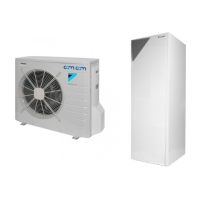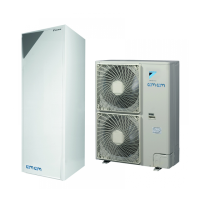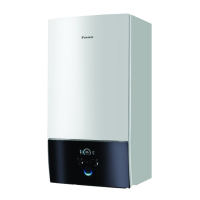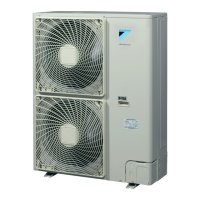11 Maintenance and service
Installer reference guide
77
ERLQ004~008CA + EHVH/X04+08S18+26CB
Daikin Altherma – Low temperature split
4P384973-1A – 2016.02
NOTICE
In Europe, the greenhouse gas emissions of the total
refrigerant charge in the system (expressed as tonnes
CO
2
-equivalent) is used to determine the maintenance
intervals. Follow the applicable legislation.
Formula to calculate the greenhouse gas emissions:
GWP value of the refrigerant × Total refrigerant charge [in
kg] / 1000
11.1 Overview: Maintenance and
service
This chapter contains information about:
▪ The yearly maintenance of the outdoor unit
▪ The yearly maintenance of the indoor unit
11.2 Maintenance safety precautions
DANGER: RISK OF ELECTROCUTION
DANGER: RISK OF BURNING
NOTICE:Risk of electrostatic discharge
Before performing any maintenance or service work, touch
a metal part of the unit in order to eliminate static electricity
and to protect the PCB.
11.2.1 Opening the indoor unit
CAUTION
The front panel is heavy. Be careful NOT to jam your
fingers when opening or closing the unit.
You just need to remove the front panel of the unit to gain access to
most parts which need maintenance. In rare cases, you may also
need to remove the switch box.
11.3 Checklist for yearly maintenance
of the outdoor unit
Check the following at least once a year:
▪ Outdoor unit heat exchanger.
The heat exchanger of the outdoor unit can get blocked up due to
dust, dirt, leaves, etc. It is recommended to clean the heat
exchanger yearly. A blocked heat exchanger can lead to too low
pressure or too high pressure leading to worse performance.
11.4 Checklist for yearly maintenance
of the indoor unit
Check the following at least once a year:
▪ Water pressure
▪ Water filter
▪ Water pressure relief valve
▪ Relief valve hose
▪ Pressure relief valve of the domestic hot water tank
▪ Switch box
▪ Descaling
▪ Chemical disinfection
▪ Anode
Water pressure
Check whether the water pressure is above 1bar. If it is lower, add
water.
Water filter
Clean the water filter.
NOTICE
Handle the water filter with care. Do NOT use excessive
force when you reinsert the water filter so as NOT to
damage the water filter mesh.
Water pressure relief valve
Open the valve and check if it operates correctly. The water may be
very hot!
Checkpoints are:
▪ The water flow coming from the relief valve is high enough, no
blockage of the valve or in between piping is suspected.
▪ Dirty water coming out of the relief valve:
▪ open the valve until the discharged water does NOT contain dirt
anymore
▪ flush the system and install an additional water filter (a
magnetic cyclone filter is preferable).
To make sure this water originates from the tank, check after a tank
heat up cycle.
It is recommended to do this maintenance more frequently.
Pressure relief valve hose
Check whether the pressure relief valve hose is positioned
appropriately to drain the water. See "7.8.5To connect the pressure
relief valve to the drain"on page38.
Relief valve of the domestic hot water tank (field supply)
Open the valve and check the correct operation. Water may be very
hot!
Checkpoints are:
▪ The water flow coming from the relief valve is high enough, no
blockage of the valve or in between piping is suspected.
▪ Dirty water coming out of the relief valve:
▪ open the valve until the discharged water does not contain dirt
anymore
▪ flush and clean the complete tank, including the piping between
the relief valve and cold water inlet.
To make sure this water originates from the tank, check after a tank
heat up cycle.
It is recommended to do this maintenance more frequently.
Switch box
▪ Carry out a thorough visual inspection of the switchbox and look
for obvious defects such as loose connections or defective wiring.

